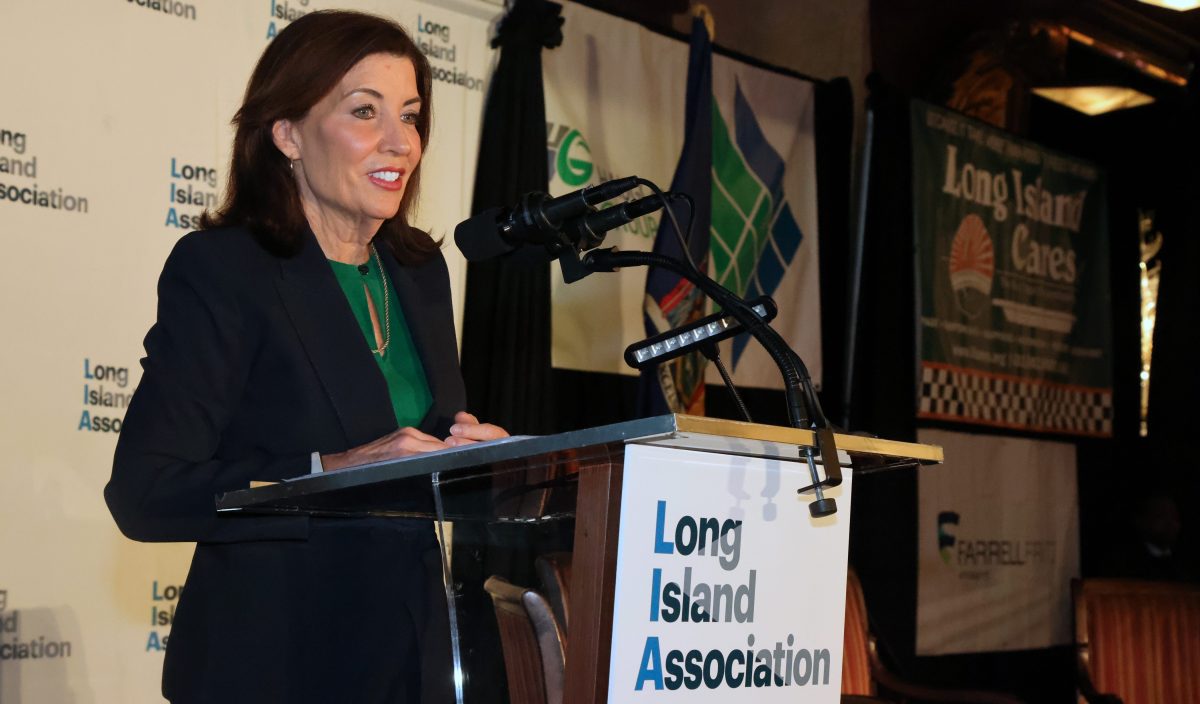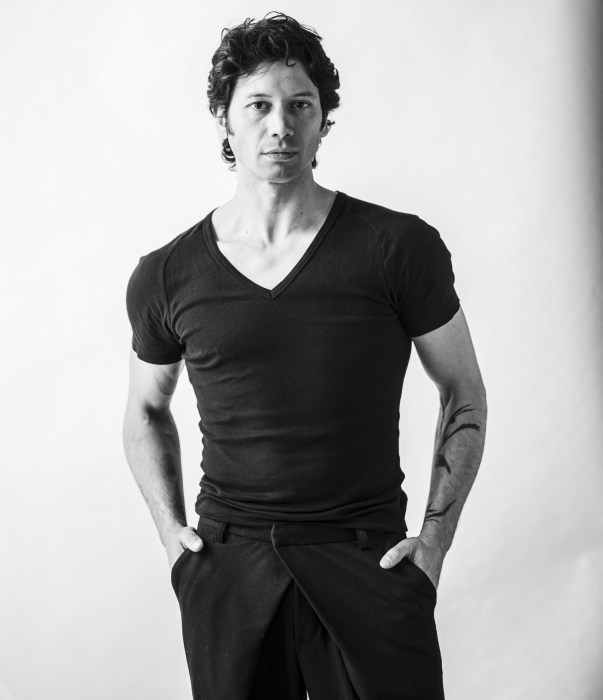A wide range of local, county, state and federal officials presented what could be called a new view of Long Island, incorporating large infrastructure projects and ambitious private initiatives, at the Long Island Association’s State of The Region breakfast.
Officials at the Jan. 10 meeting, attended by about 1,200, at Crest Hollow Country Club in Woodbury, pointed to a Long Island 2.0 with large projects already completed, in the works and in waiting that could turn an area seen as the land of “no” into the land of “now.” LIA President and CEO Matt Cohen led a panel with Suffolk County Executive Ed Romaine, Nassau County Executive Bruce Blakeman and Babylon Town Supervisor Rich Schaffer, who leads the Long Island Supervisors Association.
“You’ve seen over the last few years literally a transformation of all of Long Island, particularly the transformation of the psychology of the residents,” Gov. Kathy Hochul said. “I feel it, the sense of optimism, and the sense of possibility.”
Cohen talked about Long Island as a viable, sustainable region with jobs and homes where “people can afford to live” and an improving infrastructure.
Hochul talked about $350 million that she called a state Long Island fund for Long Island projects, but noted many other big projects benefiting from state cash.
FEDERAL FUNDING
Romaine said “we need federal and state help,” not just cooperation at the local level, while New York Sen. Chuck Schumer (D-NY), the Senate minority leader, cited examples of measures benefiting the region.
He pointed to the American Rescue Plan, as well as the Inflation Reduction Act, lowering cost of prescription drugs; Safe Communities Act, restricting younger people’s access to guns and funding.
“The money is flowing and benefiting Long Island in so many ways,” Schumer said.
He cited $400 million to improve the Long Island Power Authority grid and $615 million in anti-terrorism funds for Nassau law enforcement as examples. But he acknowledged that State and Local Tax (SALT) deduction limits hurt the region.
“It was an awful thing, an unfair cap that made us pay taxes twice,” Schumer said. “It was aimed like a dagger at the heart of New York.”
Schumer said the SALT legislation expires next year at which time there would be no limits, if no action is taken.
“Let them expire and bring relief to New York and Long Island taxpayers, full relief, not partial relief,” Schumer said. “Democrats and Republicans have to make this our number one priority. I don’t want to just raise the cap. Let’s get rid of the whole damn thing once and for all.”
COLLABORATION IS KEY
Everybody who spoke discussed the importance of bipartisanship to getting things done.
“The way to get things done is collectively,” Romaine said.
Schaffer believes the pandemic promoted cooperation.
“One of the good things out of Covid was we recognized if we worked together and with one voice, we could get things done for Long Island,” he said. “Our responsibility is to the next generation, to leave the place better than you found it after your service.”
Schaffer believes many Long Island leaders have worked together and are able to coordinate.
“The stars have aligned,” he said. “You’ve got people not only who have known each other for a long time, but who trust each other.
Romaine said Suffolk unanimously passed the largest capital budget in the county’s history.
“Long Island can be one of the economic engines of this state,” Romaine said. “You get more with honey than vinegar. I believe in working together.”
EYE ON INFRASTRUCTURE
Romaine said Suffolk used to get 23% of the state’s funds for roads and is now down to less than 7%.
“We need to rebuild our infrastructure,” Romaine said.
Blakeman said Nassau sends $14 billion more to Albany than it receives back, but the county needs state and federal funds to rebuild infrastructure, such as sewers, requiring $100 million over five years.
“Funds are available, federal and state funds,” Blakeman said. “We need to be able to get those funds, so we can do big projects and protect the environment.
Suffolk voters, for instance, approved the Suffolk County Water Quality Restoration Act with 71% in favor of bolstering sewage funds
“It says we’re ready to make changes,” Hochul said. “We’re not talking about putting high rises in your neighborhood. We’re talking about what fits for your community.”
RIDING THE RAIL
Officials often at least noted the role that investment, such as East Side Access to Grand Central Madison, and other railroad improvements play in the region.
“Seventy five percent of people who commute to the central business district from Suffolk take the LIRR and 80% from Nassau,” said Hochul, who added she rode the LIRR to the event. “This is a place I feel very much at home.”
She also discussed an additional $1.5 billion investment in the LIRR, which she said is playing a crucial role in the region.
“I understand the connectivity. The businesses, educational institutions, our life science corridor are blossoming,” Hochul said. “The Long Island Rail Road is the link to all of it.”
Romaine said that Amtrak is coming to Ronkonkoma. As part of a kind of golden age for public transit on Long Island.
HOME SWEET HOUSING
Amid low inventory of houses for sale, large housing projects are being built and more are in the works.
The more than $1 billion Station Yards project in Ronkonkoma resulted in about 1,400 units of housing. More than 500 units have gone up in Farmingdale, providing more customers for local businesses. And the Heartland project would add 9,000 units.
Schaffer also pointed to 440 units of rental housing in Bay Shore and 260 in Lindenhurst, near the train station, as well as housing in Patchogue, where he said Mayor Paul Pontieri was a pioneer.
“Patchogue is what spurred all of this, so it wasn’t taboo to talk about housing,” Schaffer said.
Hochul said it’s important to keep pushing forward, planning and building rather than clinging to the status quo.
“We have to have the ambition and the courage to do more,” Hochul said. “We can build more housing.”
New York State created the pro-housing initiative including $650 million in incentives, for things like sewers and downtown revitalization, to fund communities that say they are pro housing.
“There’s a lot of money to be had,” Hochul said. “I believe in downtown revitalization initiatives. I have been in so many communities that have been transformed.”
GOOD ENERGY
Long Island is home to Brookhaven National Laboratory, Cold Spring Harbor Laboratory, Stony Brook University, and other science centers.
BNL, with the help of federal funds, is developing cutting edge technology.
“This is going to do the kind of research that creates new things,” Schumer said. “Scientists will come from all over the world.”
Long Island also has become a hotbed of alternative energy, including solar, but also offshore energy such as the South Fork Wind Project, a 12-turbine wind farm off Montauk that Hochul called the “largest commercial-grade offshore facility in America.”
Schumer said the region, with its dense population and wind blowing off the water, “is going to be the nation’s capital for offshore wind.”
“We’re just getting started,” Hochul said. “Don’t stop believing that this is one of the many ways to bring power to homes.”
Hochul said the region also needs money from the Climate Change Super Fund Act, to protect against possible events resulting from climate change.
“These are the effects of climate change,” she said of fires and storms. “We are the first generation to feel the ill effects of climate change and the last generation that can do something about it.”
IN THE WORKS
Many projects supported by officials are still in the works. Blakeman called the Sands casino project planned for the Nassau Veterans Memorial Coliseum as the “best site in New York State for a new casino.”
“I think it would be a tremendous economic boost,” Blakeman said. “And I am very hopeful that we will be the winning bid. I believe that it will be the highest grossing casino in the United States.”
Romaine said he is hopeful of major projects, such as Midway Crossing in Ronkonkoma.
“That is at a crossroads right now. We’re going to put this together,” he said. “We can get more things done by working together.”
Hochul said Long Island, with its nearly 3 million residents, is set to play a key part in the state’s future.
“We get together often and talk about the challenges ahead and how to conquer them together,” Hochul said of meetings with local supervisors and other officials. “Long Island is very much top of mind for us.”
She said fiscal policy needs to look out for the middle class, citing expanded child tax credits as an example. “I have a couple of ideas,” she added. “If you’re a middle class taxpayer, you’re going to like to hear this.”
Still, Hochul said Long Island and other businesses have gone through some tough times, due to the pandemic and supply chain disruptions. But she said she is optimistic for Long Island and expects to keep funds flowing to help.
“I thank you for going through some tough times,” Hochul told businesspeople. “You endured and persevered. You have New York’s sense of the possible. Nothing can keep us down, especially here on Long Island.”
































